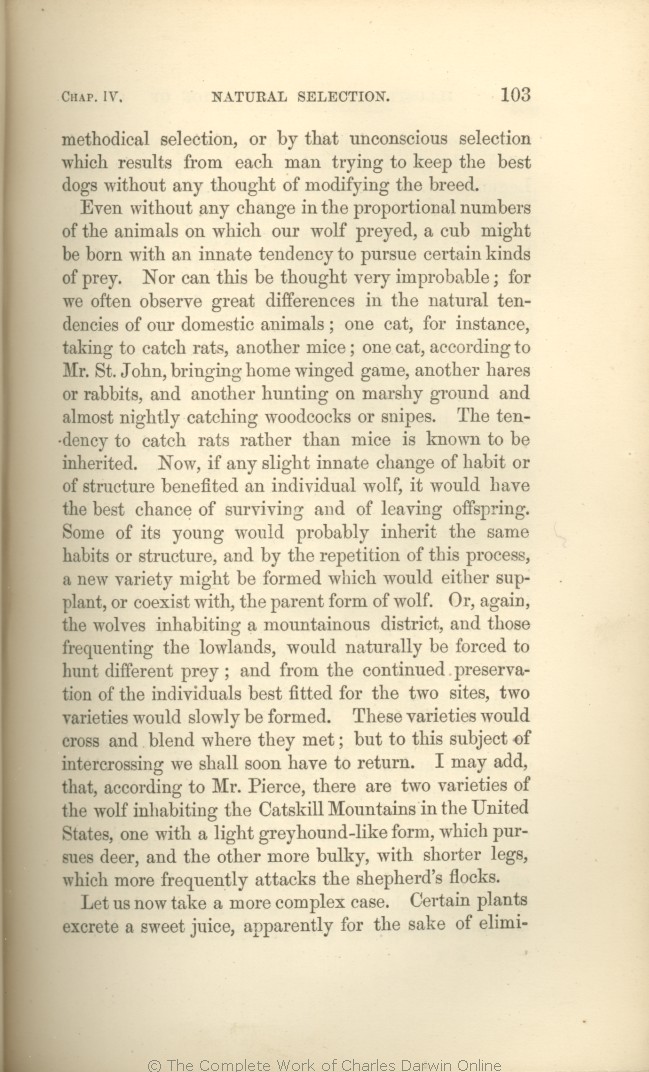methodical selection, or by
that | that 1859 1860 1861 1866 1872 | that 1869 |
| unconscious 1859 1860 1861 1866 1869 |
| kind of unconscious 1872 |
| results 1859 1860 1861 1866 1869 | | follows 1872 |
| 14 blocks not present in 1859 1860 1861 1866; present in 1869 1872 | | I may add, that, according to Mr. Pierce, there are two varieties of the wolf inhabiting the Catskill Mountains in the United States, one with a light greyhound-like form, which pursues deer, and the other more bulky, with shorter legs, which more frequently attacks the shepherd's flocks.
It should be observed that, in the above illustration, I speak of the slimmest individual wolves, and not of any single strongly-marked variation having been preserved.
In former editions of this work I sometimes spoke as if this latter alternative had frequently occurred.
I saw the great importance of individual differences, and this led me fully to discuss the results of unconscious selection by man, which depends on the preservation of the better adapted or more
valuable individuals, and on the destruction of the worst.
I saw, also, that the preservation in a state of nature of any occasional deviation of structure, such as a monstrosity, would be a rare event; and that, if preserved,
it would generally be lost by subsequent intercrossing with ordinary individuals.
Nevertheless, until reading an able and valuable article in the 'North British Review' (1867), I did not appreciate how rarely single variations, whether slight or strongly-marked, could be perpetuated.
The author takes the case of a pair of animals, which produce
during their lifetime two hundred offspring, of which, from various causes of destruction, only two on an average survive to procreate
their kind.
This is rather an extreme estimate for most of the higher animals, but by no means so for many of the lower organisms.
He then shows that if a single individual were born, which varied in some manner, giving it twice as good a chance of life as that of the other individuals, yet the chances would be strongly against its survival.
Supposing it to survive and to breed, and that half its young inherited the favourable variation; still, as the Reviewer goes on to show, the young would have only a slightly better chance of surviving and breeding; and this chance would go on decreasing in the succeeding generations.
The justice of these remarks cannot, I think, be disputed.
If, for instance, a bird of some kind could procure its food more easily by having its beak curved, and if one were born with its beak strongly curved, and which consequently flourished, nevertheless there would be a very poor chance of this one individual perpetuating its kind to the exclusion of the common form; but there can hardly be a doubt, judging by what we see taking place under domestication, that this result would follow from the preservation during many generations of a large number of individuals with more or less curved
beaks, and from the destruction of a still larger number with the straightest beaks.
It should not, however, be overlooked that certain variations,
which no one would rank as mere individual differences, frequently recur owing to a similar organisation being similarly acted on,—of which fact numerous instances could be given with our domestic productions.
In such cases, if a
varying individual did not actually transmit to its offspring its newly-acquired character, it would undoubtedly transmit,
as
long as the existing conditions remained the same, a still stronger tendency to vary in the same manner.
|
| 1 blocks not present in 1859 1860 1861 1866 1872; present in 1869 | | The conditions might indeed act in so energetic and definite a manner as to lead to the same modification in all the individuals of the species without the aid of selection.
|
|
Even without any change in the proportional numbers of the animals on which our wolf preyed, a cub might be born with an innate tendency to pursue certain kinds of prey. Nor can this be thought very improbable; for we often observe great differences in the natural tendencies of our domestic animals; one cat, for instance, taking to catch rats, another mice; one cat, according to Mr. St. John, bringing home winged game, another hares or rabbits, and another hunting on marshy ground and almost nightly catching woodcocks or snipes. The tendency to catch rats rather than mice is known to be inherited. Now, if any slight innate change of habit or of structure benefited an individual wolf, it would have the best chance of surviving and of leaving offspring. Some of its young would probably inherit the same habits or structure, and by the repetition of this process, a new variety might be formed which would either
supplant, | supplant, 1866 | | supplant 1859 1860 1861 |
| with, 1866 | | with 1859 1860 1861 |
| parent form of 1860 1861 1866 |
| parent-form 1859 |
| ..... 1860 1861 1866 | | of 1859 |
| would 1861 1866 | | might 1859 1860 |
| shepher's 1866 | | shepherd's 1859 1860 1861 |
|









